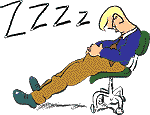 | Narcolepsy |  |
 | Narcolepsy |  |
NarcolepsyImagine listening to a funny joke, then in the middle of laughing, your legs suddenly buckle and you are unable to move for the next several minutes. Maybe you are in class, but you are
incredibly drowsy and finally just can't stay awake even though you had
plenty of sleep the night before. These are examples of what people with
narcolepsy experience. Maybe you are in class, but you are
incredibly drowsy and finally just can't stay awake even though you had
plenty of sleep the night before. These are examples of what people with
narcolepsy experience.People with narcolepsy have trouble staying awake; they often feel drowsy and fall asleep, even in the middle of the day, sometime in the middle of activities that produce strong emotions. It is thought that narcolepsy occurs when rapid eye movement (REM) sleep occurs while people are awake. Although the cause of narcolepsy is unknown, it does occasionally run in families. If one person in a family has the disorder, another relative may be susceptible to developing it if certain environmental triggers occur.
Symptoms
TreatmentMedications such as stimulants (amphetamines, Ritalin) that increase alertness are often used to treat narcolepsy. However, stimulants may cause side effects including headaches, nervousness, and mood changes. Antidepressant medication is also used to treat narcolepsy. A new drug called Provigil was
approved by the US Food and Drug Administration in late 1998. Provigil
promotes wakefulness and appears to have fewer side effects than
stimulants such as
amphetamines.
A new drug called Provigil was
approved by the US Food and Drug Administration in late 1998. Provigil
promotes wakefulness and appears to have fewer side effects than
stimulants such as
amphetamines. In the Sleep Clinic at Stanford University, Doberman dogs that have narcolepsy are bred. Work with these animals has led to the discovery of the gene for narcolepsy.
Fast Facts
|
| Did you
know?
|
Narcolepsy was first described in the 1880s by French physician Jean-Baptiste Edouard Gelineau. |
|
References:
|
| BACK TO: | Neurological Disorders | Table of Contents |
![[email]](./gif/menue.gif) Send E-mail |
![[newsletter]](./gif/menunew.gif) Get Newsletter | ![[search]](./gif/menusea.gif) Search Pages |
By Ellen Kuwana, Neuroscience for Kids Staff Writer